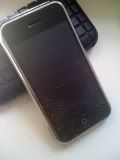When I saw this, many thoughts rushed through my head...
"THIS is what VoIP has been waiting for! Something simple and sexy that can operate wirelessly"
"Did Cisco Telepresence have a baby?"
"Polycom will make their verison of this. Just you wait."
But having watched the demo, I felt somewhat... shortchanged. As though the hype that its primary characteristics created wasn't done justice by its performance.
The idea of being able to create a Skype ID on the spot I liked - as the consumer market this reaches out to may not necessarily use Skype - and this takes away a lot of friction, making the concept of Skype seem a lot friendlier to this device's users.
The problem here, though, is that typing is strictly directional pad-based. WPM rates will be slashed to minscule percentages of what they are on a regular keyboard. This replaces the friction of having to go onto a computer to create a Skype account.
How could this have been avoided?
Evidently, an alternative input method is the solution here. Its layout doesn't look as though it would permit a full, hard, built in keyboard.
The modern solution would be to accept speech-to-text technology. After all - this is a phone, isn't it? So, the microphone is right up there with the sound output as the most important functions.
I've got a feeling, though, that names could be misinterpreted quite easily, causing frustration, and thus, replacing friction we're trying to remove here.
It's no secret that touchscreen technology is space saving, sexy, and practical. It's also no secret that it's a winner with consumers. I do believe that the iPhone speaks for itself, accompanied by the Nintendo DS, tablet PCs, the BlackBerry Storm, and Palm Pre.
As such, one would think that a touchscreen on a device like this would be highly beneficial. As touchscreen typing involves mostly thumb movement, from what I can see, it has a form factor that would allow you to put your other fingers on the back, to give you a better grip (one you're used to, if you're a frequent touchscreen typist like myself).
Aside from allowing easier input, having a touchscreen would open up a myriad of possibilities. The array of options that can be scrolled through with the directional pad looks just like Cover Flow. Last time I checked, that was a main selling feature of the iPhone and iPod Touch. It also looks right out of PictureFlow on Windows Mobile.
So, you can type more easily, AND navigate more easily. It also adds to its primary characteristics, making it irresistible and an easier sell.
Regardless of whether or not touchscreen was to be there or not, I have one final suggestion for input, and that is an external keyboard.
I know what you're thinking - that just adds bulk and is the last thing anybody is going to want to carry around.
The fact is, though, not everybody wants to type touchscreen (hence all the people who buy BlackBerries off of me), so an external keyboard may be necessary.
Solutions might include having a fold-out one from the base, or half keyboards that fold out on the sides. But I think it should be an accessory.
An external keyboard is an excellent upsell - very high margin. The frustration of d-pad typing could be used to Asus and Skype's advantage - "Want a full keyboard? Only $29.99 extra!"
As for portability - it could be designed so that it can attach to the device smoothly.
Overall, I am quite impressed with the concept - but a V2 should be on the way if they want to make it even more consumer friendly.
Marketing-wise: A demonstration stand at Wal Mart would draw "ooh"s and "ahh"s - even more so than the iPhone.
Why?
a) Video calling hasn't quite been tapped as a consumer solution just yet
b) It wouldn't cost as much, nor require a service agreement as the iPhone does.
Here's a link to the product's page on the Skype website, for reference: http://www.skype.com/intl/en-gb/allfeatures/videophones/
Subscribe to:
Post Comments (Atom)


No comments:
Post a Comment